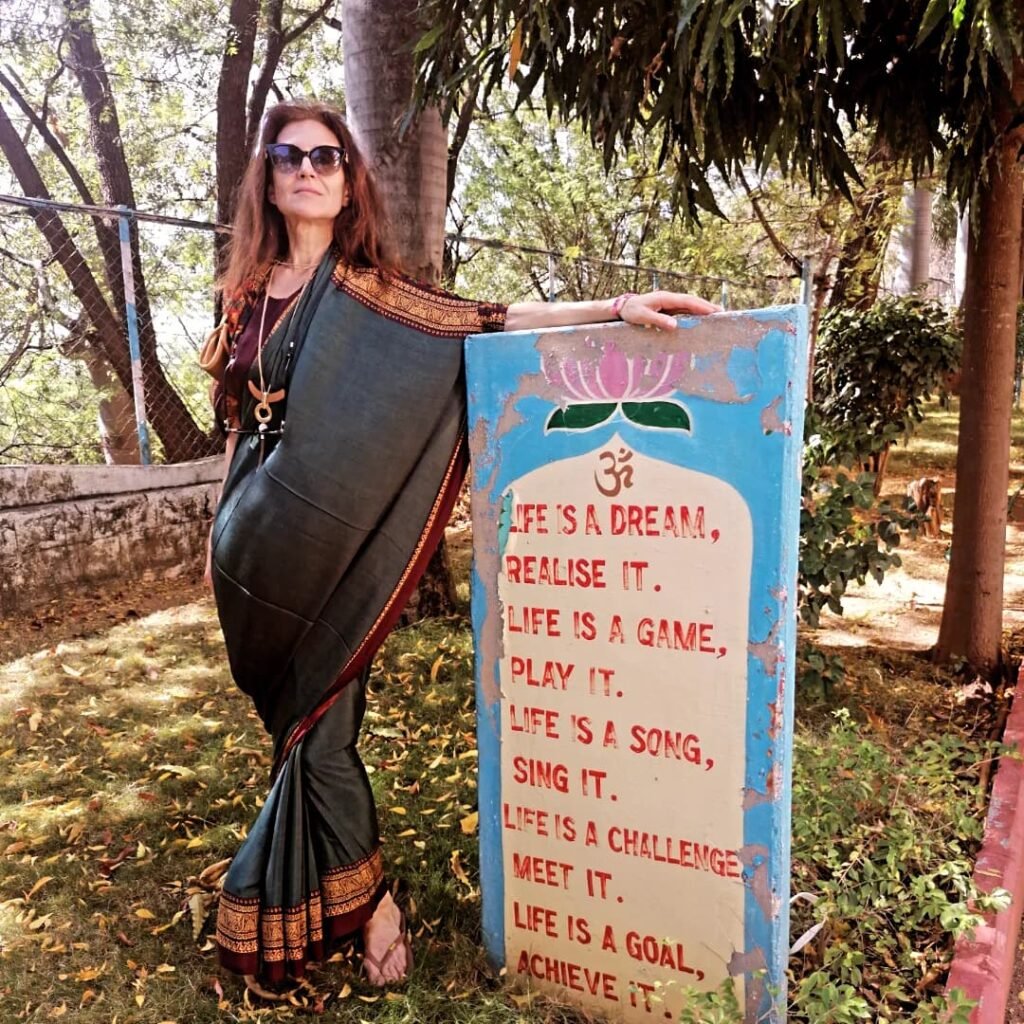A Different Kind of India
The next morning, our journey to Puttaparthi began. It was long but not tiring. The ride to the Varanasi airport and the flight to Bangalore passed quickly. Soon, we were in a taxi heading toward the dreamlike destination I knew nothing about—Puttaparthi, the town of Sai Baba.
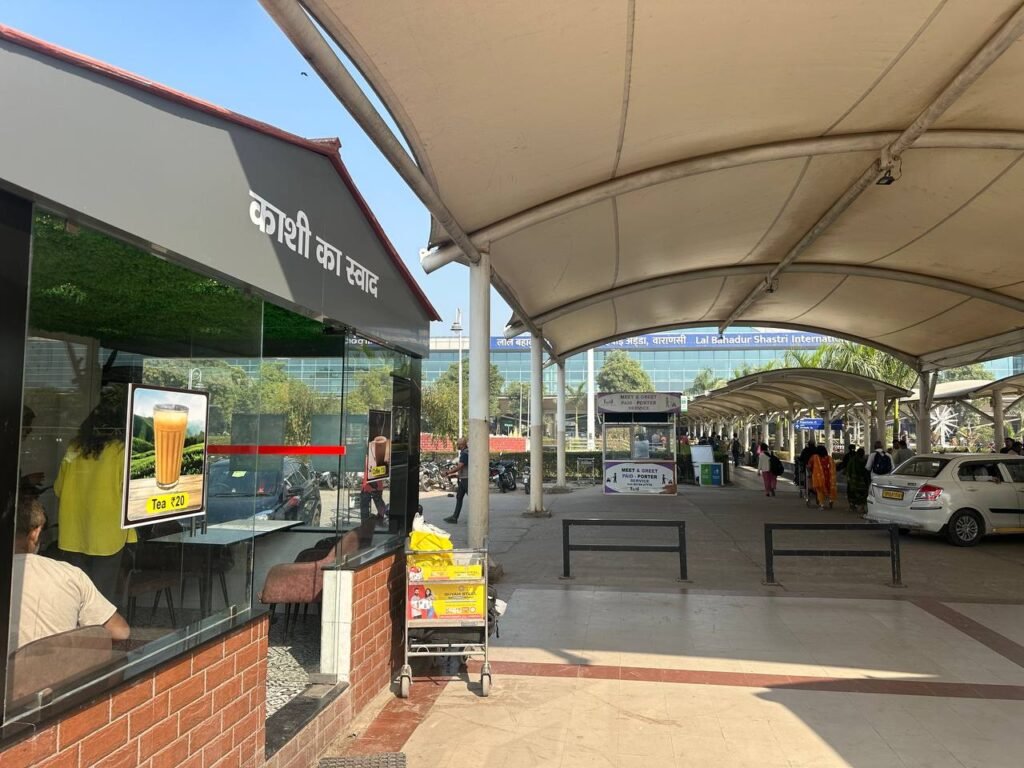
The view from the window finally began to please the eye—palm trees and mountains bathed in the gentle light of the setting sun. Everything spoke of rest and a return to ordinary human vibrations, without the emotional rollercoaster of Varanasi and the rest of India. Nastya, whom I hadn’t mentioned in a while, stepped back into the scene. Her face glowed with a smile, her eyes radiating that inner light and the typical mix of bliss and distraction she carried when she was happy.
Nastya had often spoken of Puttaparthi as a soulful sanatorium—not to be confused with a psychiatric hospital. After our intense immersion into India, Puttaparthi took the final stage of our journey. And as we would soon discover, everything in this town had indeed been shaped by the grand dream of one man—for millions of others.
As we drove on, we enjoyed the peace of the ride. Nastya shared her “music of strength,” composed for different people. Her unique ability to feel others and see the divine in each one makes her music and poetry deeply personal.
Arrival in Puttaparthi
A couple of hours later, we arrived in Puttaparthi and, as had become our travel tradition, split into different accommodations. Nastya, Sveta, and Mykola went to a hotel, while Kirill and I moved into a spacious three-room apartment he had found—comfortable and equipped with all necessary amenities. I must say, Puttaparthi immediately stood out compared to every other Indian city we had visited. We were about to spend three very special days in this unique town.
The Ashram of Sai Baba
The next morning, after a rather unusual breakfast—the kitchen was closed despite it being 9 a.m.—Kirill and I headed to meet the rest of our group. The plan was to move into Sai Baba’s ashram, which deserves a separate introduction.
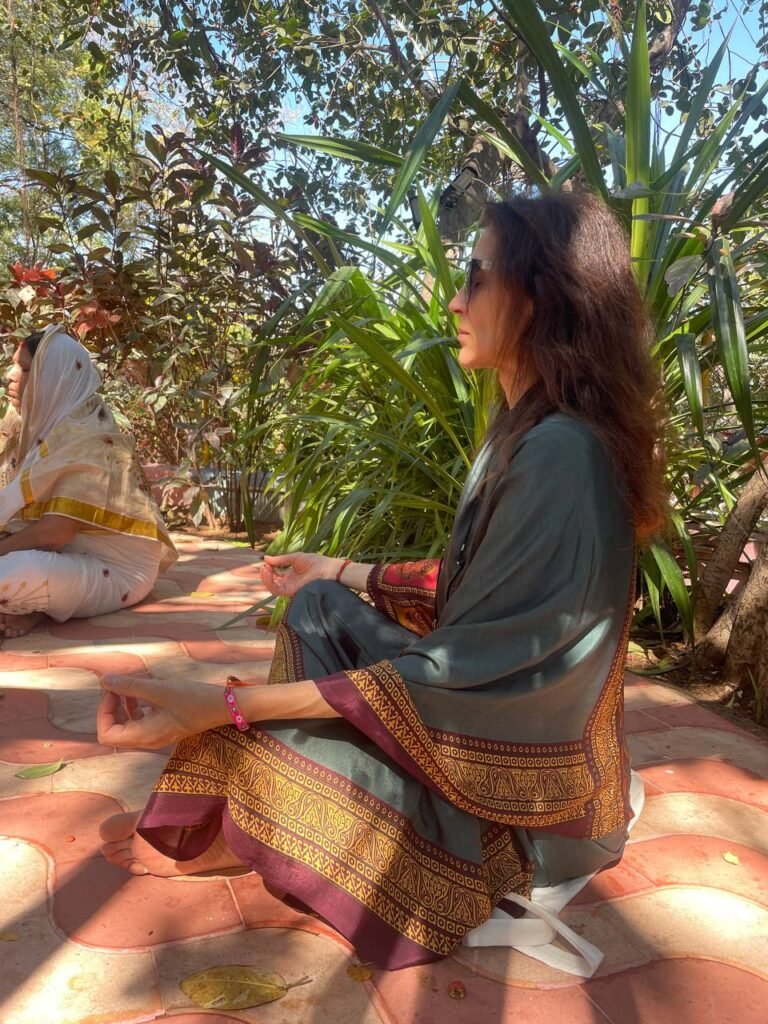
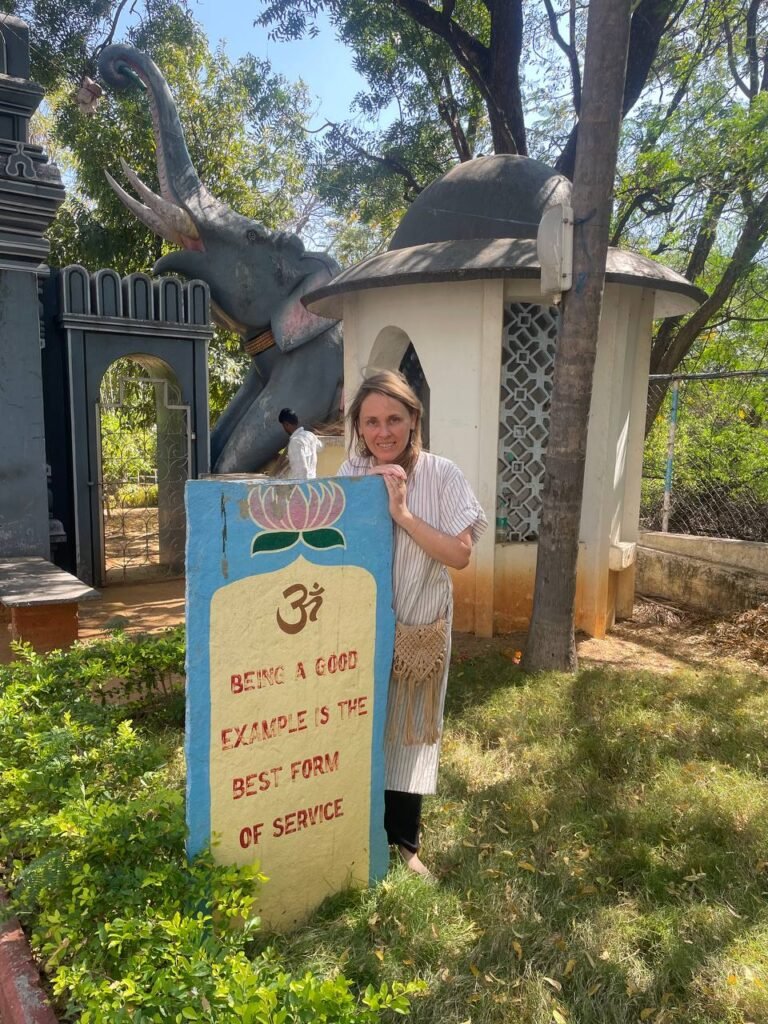
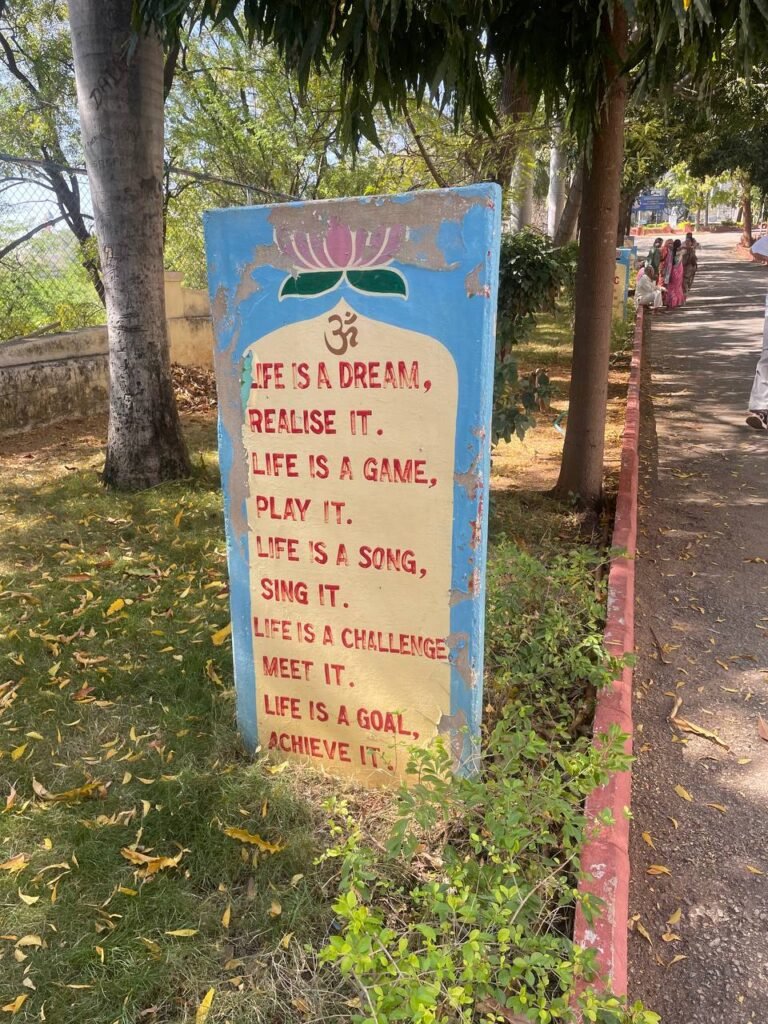
The Ashram of Sai Baba is a place of pilgrimage, a spiritual world within a town. Puttaparthi, once a tiny village in Andhra Pradesh, became a magnet for tens of thousands of devotees because of one man—Sri Sathya Sai Baba, who became a legend. For some, he was a saint. For others, a miracle worker. For yet others, a divine incarnation. Whatever the view, he succeeded in building not just an ashram, but an actual city of dreams.
The Child Who Claimed to Be God
Sai Baba was born in 1926 into a theatrical family. His father was said to be a village dramatist and actor—perhaps that’s where young Sathya inherited his dramatic flair, love for performance, and exceptional charisma. Even as a child, he displayed extraordinary gifts: quoting sacred texts, composing poetry, and radiating wisdom far beyond his years. At age fourteen, he shocked everyone by declaring that he was the reincarnation of the saint Shirdi Sai Baba and that he had come to remind humanity of love, truth, righteousness, and selfless service.
He was an incredibly charismatic figure, clothed in a simple orange robe, with a cloud-like mane of hair, an endlessly soft smile, and a gaze that penetrated the soul. The stage—in the broadest sense—was his natural element. Whether giving darshans, meeting with students, or simply being silently present, he could hold the attention of thousands while remaining completely still. It left a lasting impression.
Prasanthi Nilayam – The Abode of Peace
The ashram, Prasanthi Nilayam—which means “Abode of Supreme Peace”—is a well-kept campus with flowering gardens, temples, dining halls, guesthouses, banks, classrooms, and all the services needed for a comfortable stay. Everything is built on the ideals of service, love, and selflessness. It’s a place where order prevails, no one tries to sell you souvenirs, and—strange as it sounds for India—a quiet joy pervades the atmosphere.
Sai Baba was a spiritual teacher and the visionary behind numerous social projects. Schools, hospitals, a university, and a free village water supply system all stemmed from his dream—a dream grounded in the belief that all religions are one at their core and that the highest spiritual practice is love and service.
We planned to stay in the ashram for a few days, and I was curious whether this place could truly quiet the mind and offer the reprieve we so badly needed after our intense Indian journey. But first, we met with our friends and wandered the tidy streets of Puttaparthi, where even the passersby seemed to float slightly above the ground like Chagall characters, walking under the all-seeing gaze of Sai Baba.
Living Under the Gaze of Sai Baba
Indeed, portraits of Sai Baba are displayed all over the town, alongside quotes from his teachings and speeches. At first, it felt a bit strange. But slowly, the intent behind it started to make sense. I can’t say whether this was his directive or the free will of his devotees—but there is something rational in it. Human nature needs constant reminders. As the Russian saying goes, “Out of sight, out of mind.”
And so we arrived at the ashram. At the reception, we were told that the rooms were modest and that single travelers could only stay in the dormitory. Married couples were allowed private rooms. Upon hearing the word “modest,” Kirill and I, as we often did, made a silent decision: we would keep our apartment and house Sveta at the ashram in relative comfort. Kirill agreed to pose as her husband and get a private room.
Separate Worlds, Shared Purpose
In the ashram, men and women function separately—restaurants, meditation areas, and other spaces are divided, except for couples. But this, too, is intentional. It helps focus visitors on their spiritual journey. Nothing should distract from the essential. Sai Baba, a master organizer, anticipated how to remove as many distractions as possible on the path to the self, to God, or whatever higher purpose brings people to the ashram.
After receiving all the necessary information, we returned to our hotel and apartment to collect our things. I was free to relax—we still had another day in the apartment. The others went to complete the check-in process, which took them a good hour and a half. No one here was in any rush.
I enjoyed a peaceful lunch and strolled through local shops. I ordered myself a royal sari made of Kashmiri silk—in which, three weeks later, I would lecture Italian high school students (my husband’s students) about Hinduism. It’s funny, considering I knew very little about India or Hinduism just a month earlier. And though I wouldn’t call myself an expert even now, two weeks of vivid impressions were enough to fill several hours of lectures.
So, despite the excellent dining halls at the ashram, I had a quiet lunch at a vegetarian café. I just wanted a moment alone.
Continue reading the story of Puttaparthi: Part 2 – At the Edge of the Universe: A Journey Through Puttaparthi
🧳 This article is part of a travel series exploring India. Read the full journey below:
- The Word Was with God – How India Found Me
A personal and spiritual awakening begins in India’s heartland. - Delhi Shock – My First Night in India
Raw impressions from the chaotic, vibrant capital. - The Divine Heart of India – Vrindavan, Krishna, and Rama
A deep dive into sacred cities and mythic lore. - Madness or Faith? A Pilgrimage to Maha Kumbh Mela
Encountering the world’s largest religious gathering. - Exploring Hinduism’s Greatest Festival – Maha Kumbh Mela 2025
A guide and reflection on faith, crowds, and ritual. - To Be or Not to Be: On the Eve of the Great Bathing
Facing existential questions on the threshold of the sacred. - Where the Fires Burn – First Encounters with Varanasi
A visceral arrival in India’s most mystical city. - Between Life and Flame – Tales from the Ganges
Reflections on death, devotion, and the river’s eternal flame. - Journey Through Varanasi – Saturn, Sound, and Spirit
Myths, music, and meaning in India’s spiritual capital. - Puttaparthi: A Dream Made Real
A village transformed by faith: the story of Sathya Sai Baba’s birthplace. - At the Edge of the Universe – A Journey Through Puttaparthi
A cosmic path of devotion, silence, and the soul’s unfolding.

